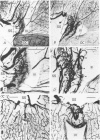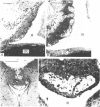Abstract
1. Febrile responsiveness of rabbits and rats to intravenous (I.V.) or intracerebroventricular injection of human recombinant interleukin-1 alpha (IL-1 alpha), human recombinant interleukin-1 beta (IL-1 beta) and prostaglandin E2 was examined. 2. The I.V. injection of both IL-1 alpha and IL-1 beta produced dose-dependent fever over a range of 0.05-2.0 micrograms/kg. A small dose of IL-1 alpha (0.5 micrograms/kg) or IL-1 beta (0.5 micrograms/kg) produced a monophasic patterned fever in both rabbits and rats. A large dose (2.0 micrograms/kg) of IL-1 alpha or IL-1 beta produced a biphasic fever in rabbits, but monophasic fever in rats. Febrile responses in rabbits induced by I.V. injection of IL-1 alpha or IL-1 beta were significantly greater than those in rats induced by these same injections. Furthermore, in both species, the pyrogenicity of I.V. IL-1 beta was greater than that of IL-1 alpha. 3. The intracerebroventricular injection of both IL-1 alpha and IL-1 beta produced dose-dependent fever over a range of 0.2-20 ng. In rabbits and rats, the ventricular injections of IL-1 alpha and IL-1 beta produced fever with almost the same pattern--monophasic, regardless of injection doses. Although febrile responsiveness of rabbits to ventricular injection of IL-1 alpha was greater than that of rats, responsiveness to IL-1 beta was almost the same in both species. Pyrogenicity of ventricular IL-1 beta was greater than that of IL-1 alpha. However, febrile responses in rats induced by ventricular injections of several doses (2-2000 ng) of prostaglandin E2 were greater than those in rabbits. 4. The present results show that febrile responsiveness of rabbits to I.V. IL-1 is significantly greater than that of rats. However, fever sensitivity within the central nervous system (CNS) of rats is not lower compared with that of rabbits. Therefore, we considered that between the two species there exist structural differences in the organum vasculosum laminae terminalis (OVLT), which is currently believed to be the pathway of pyrogen to the CNS and/or the site of production of pyrogenic prostaglandins. 5. Histological examinations showed that the rabbit's OVLT has two vascular components with capillaries, one in the layer near the third ventricle and the other in the layer near the subarachnoideal space. However, the rat's OVLT only has a single component, in the layer near the subarachnoideal space.(ABSTRACT TRUNCATED AT 400 WORDS)
Full text
PDF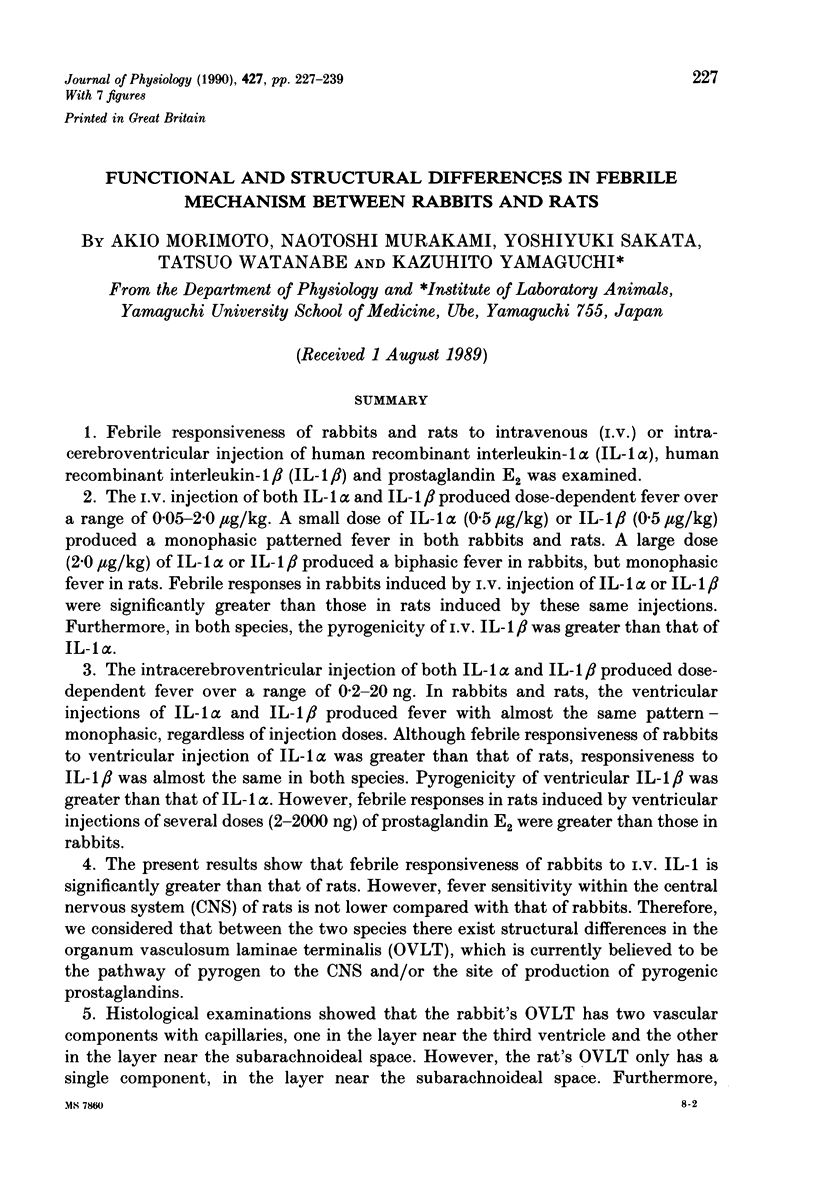
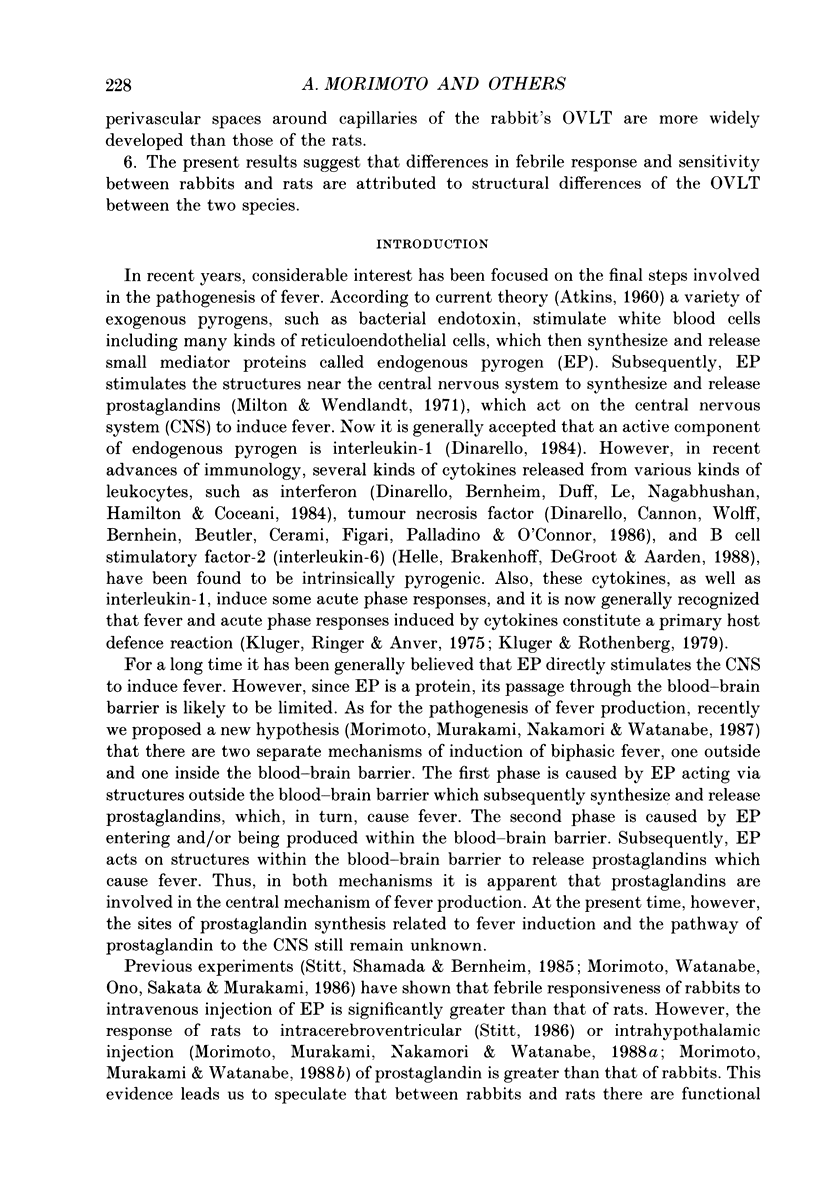
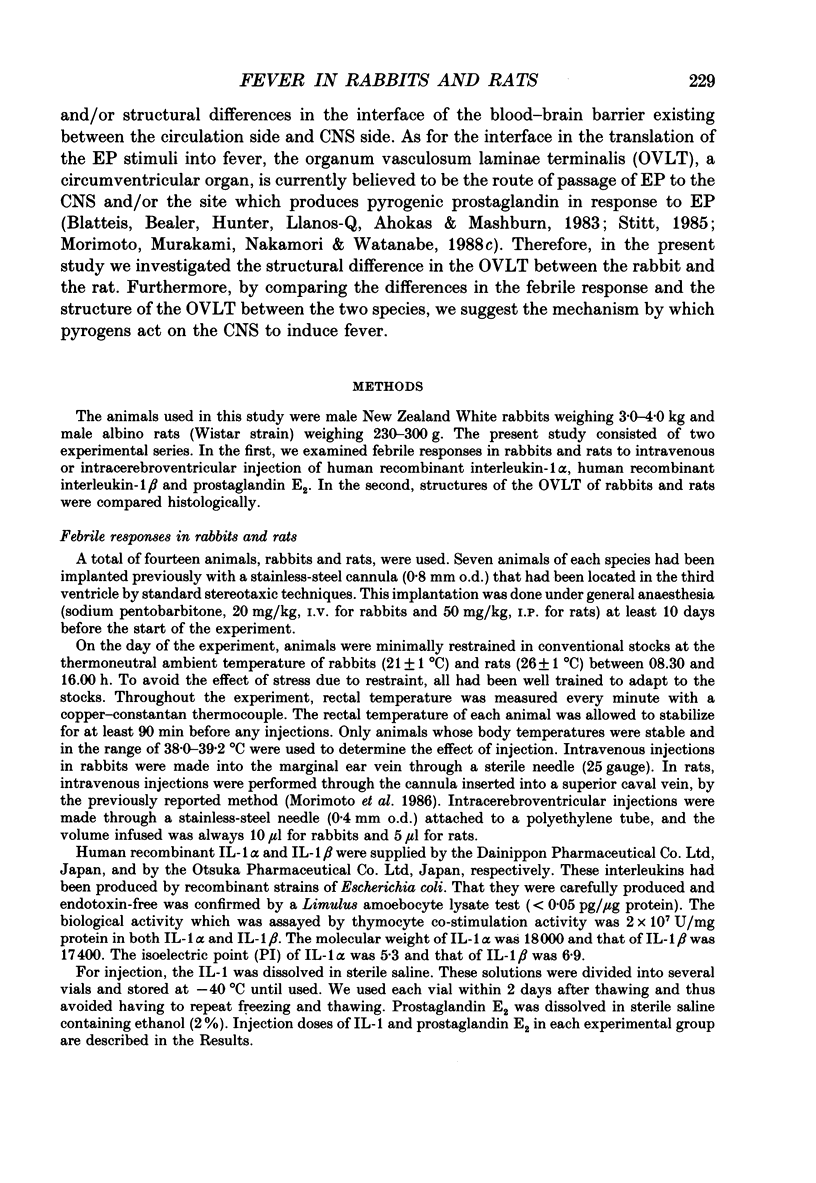
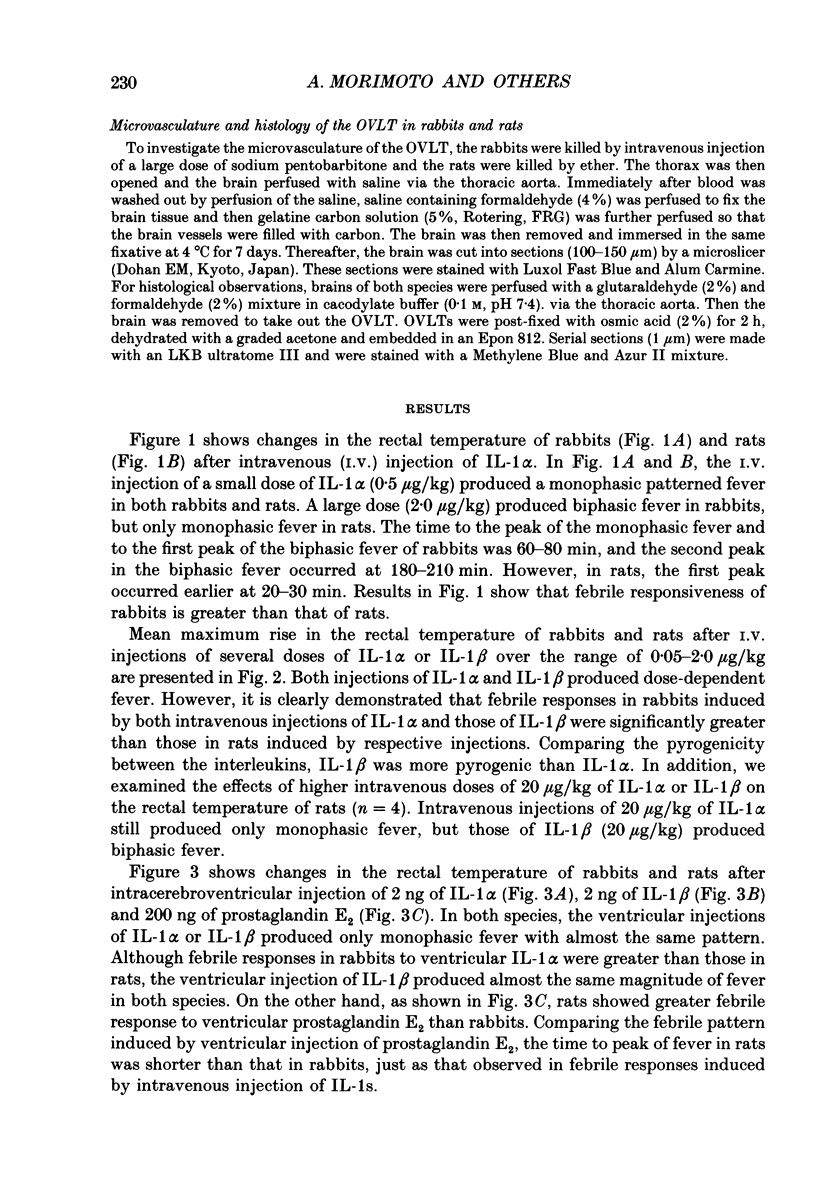
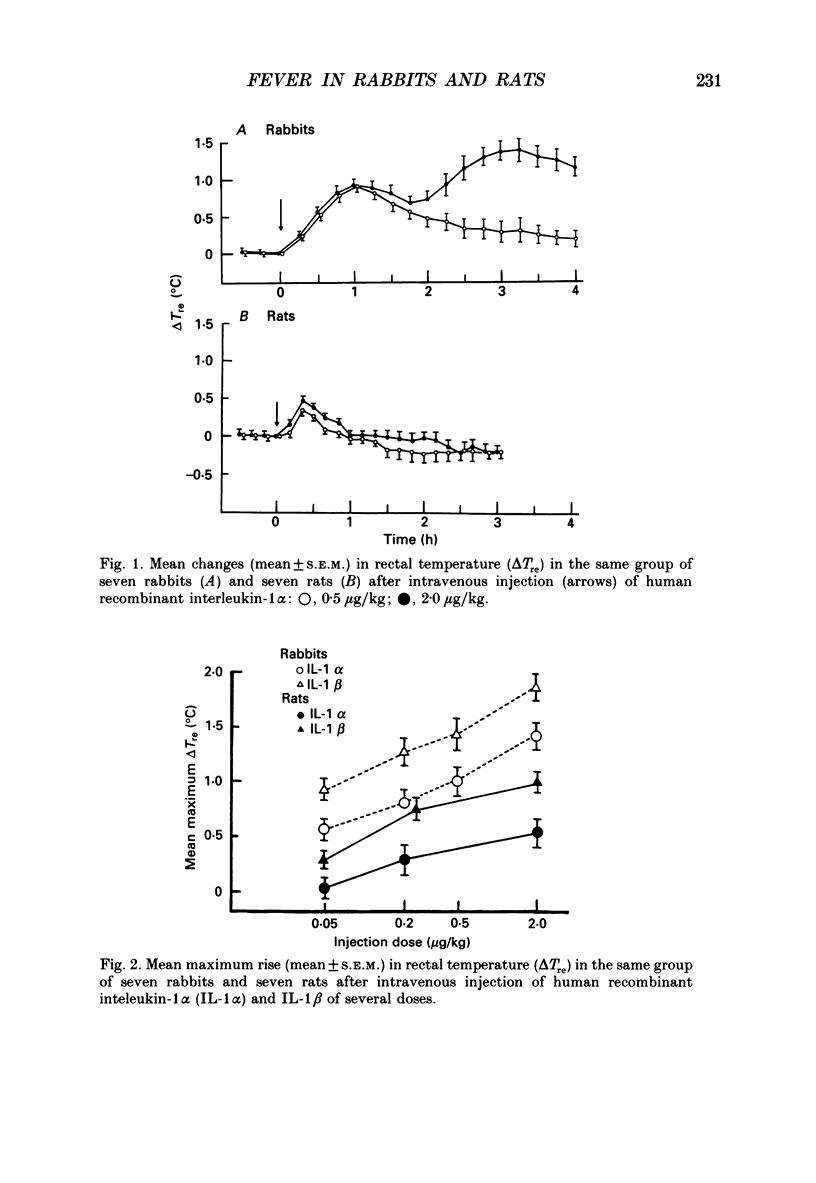
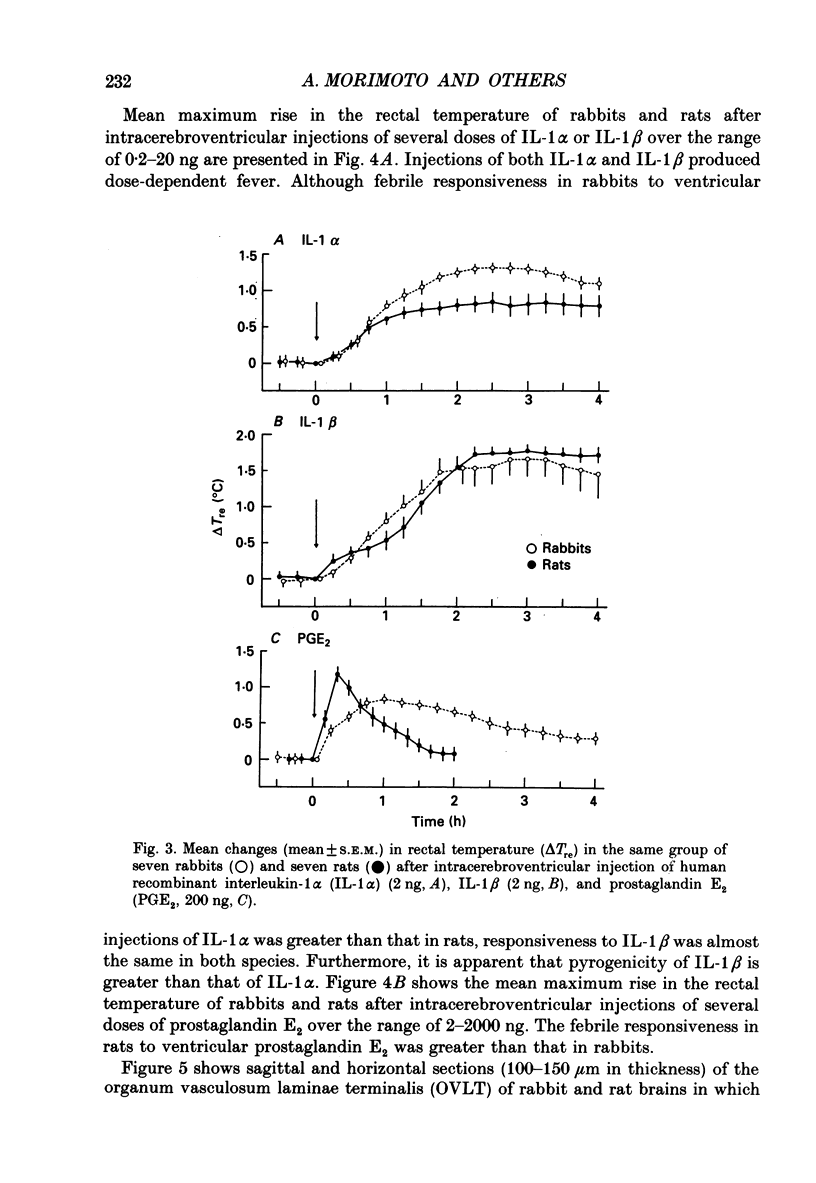
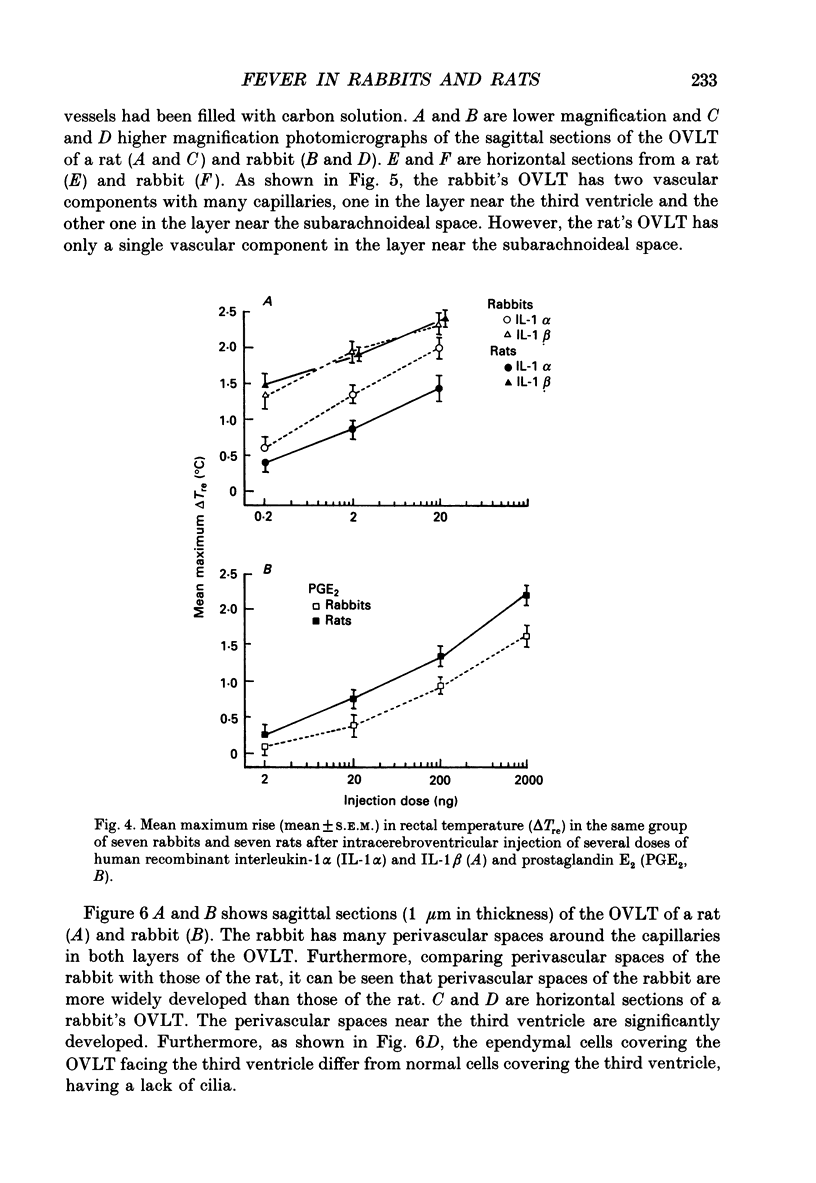
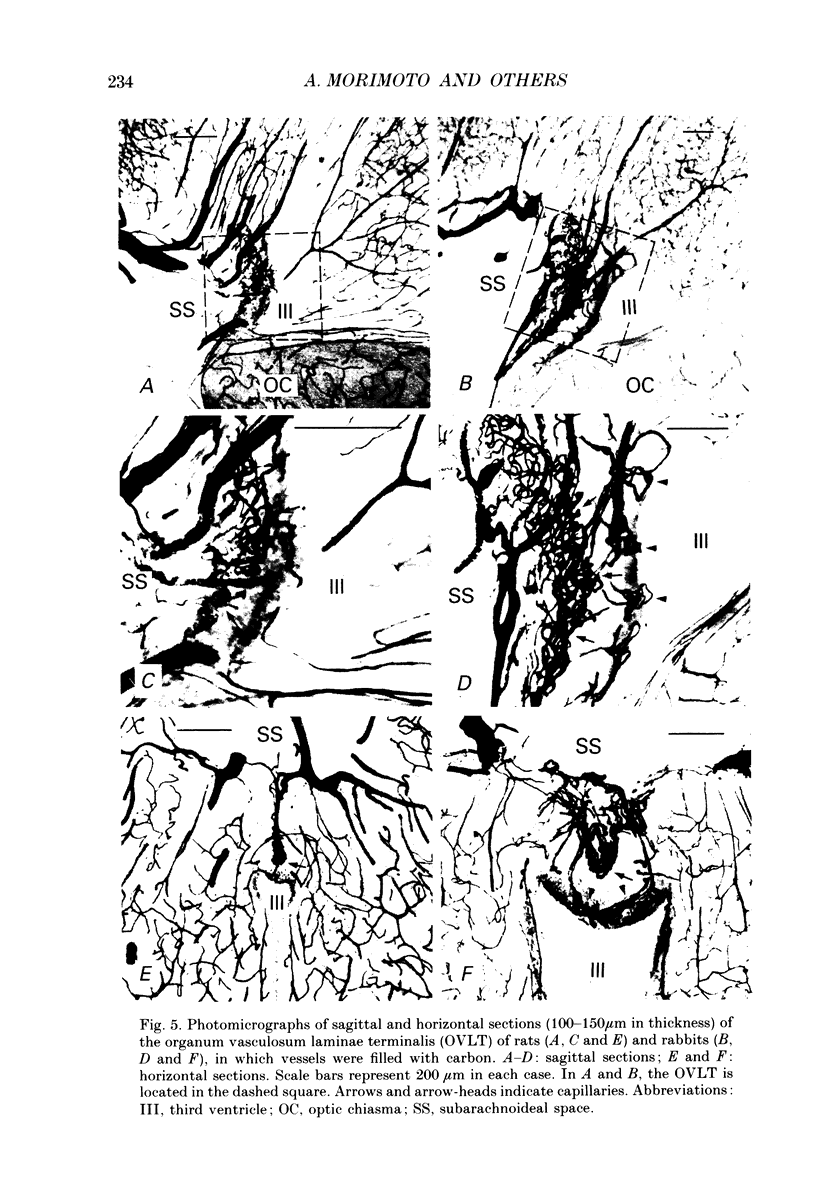
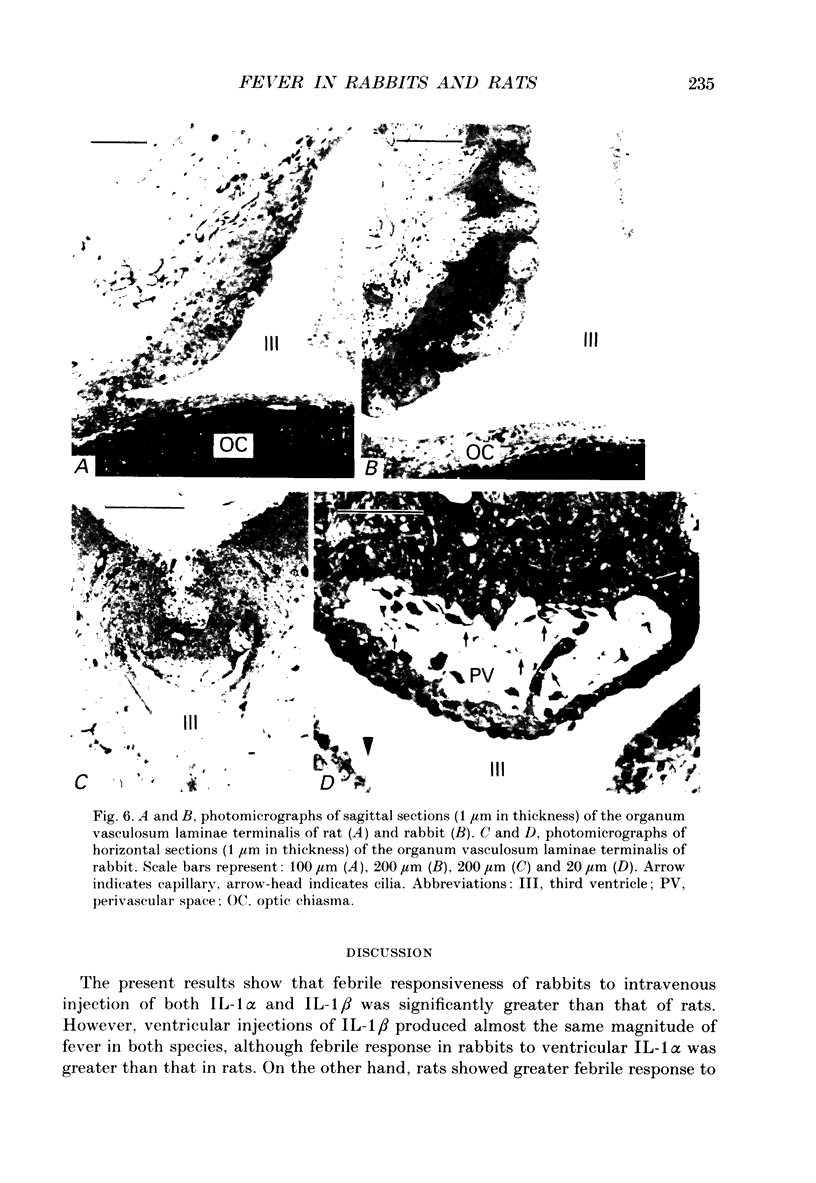
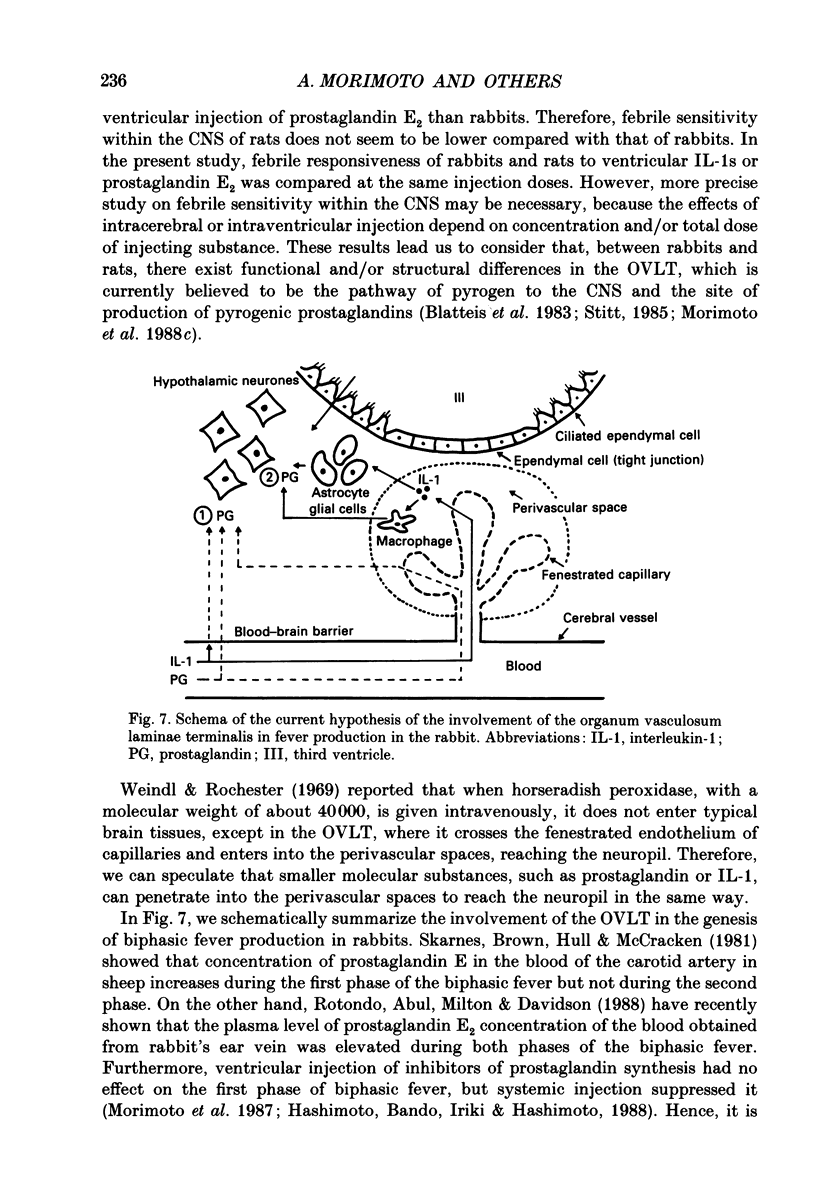
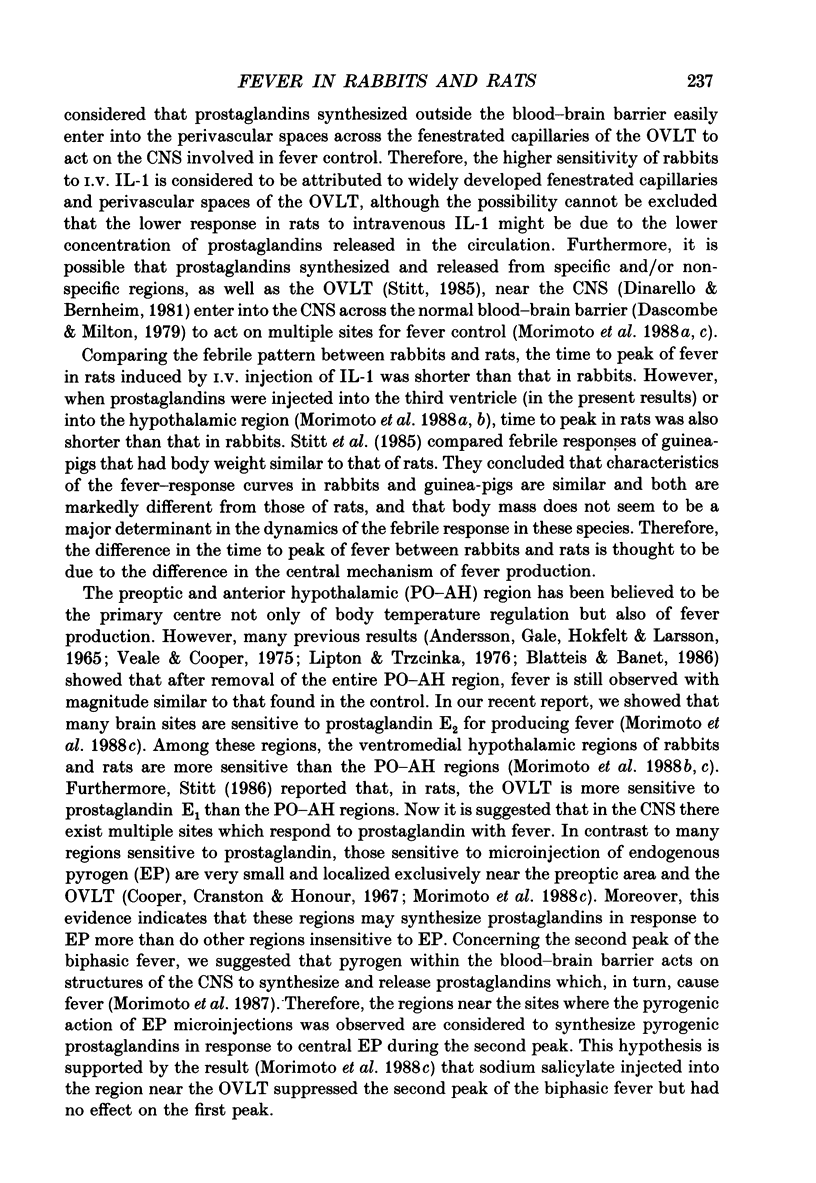
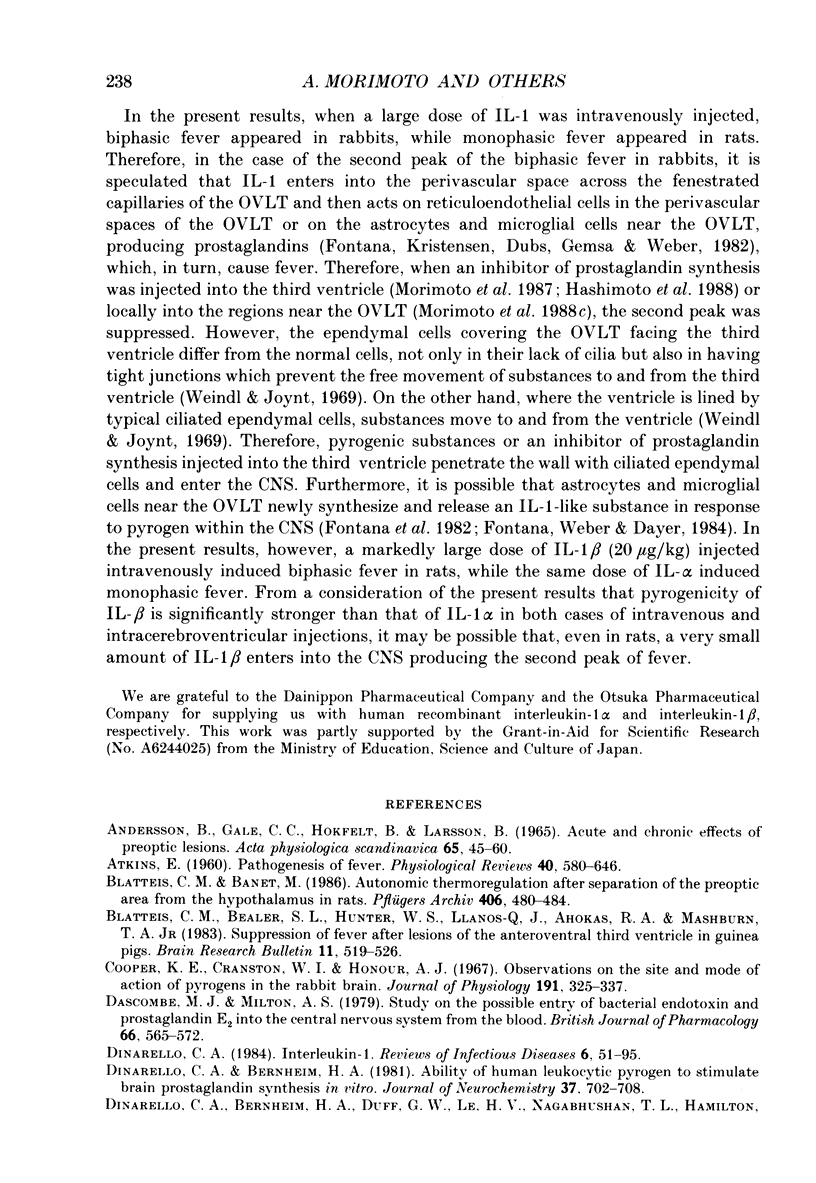
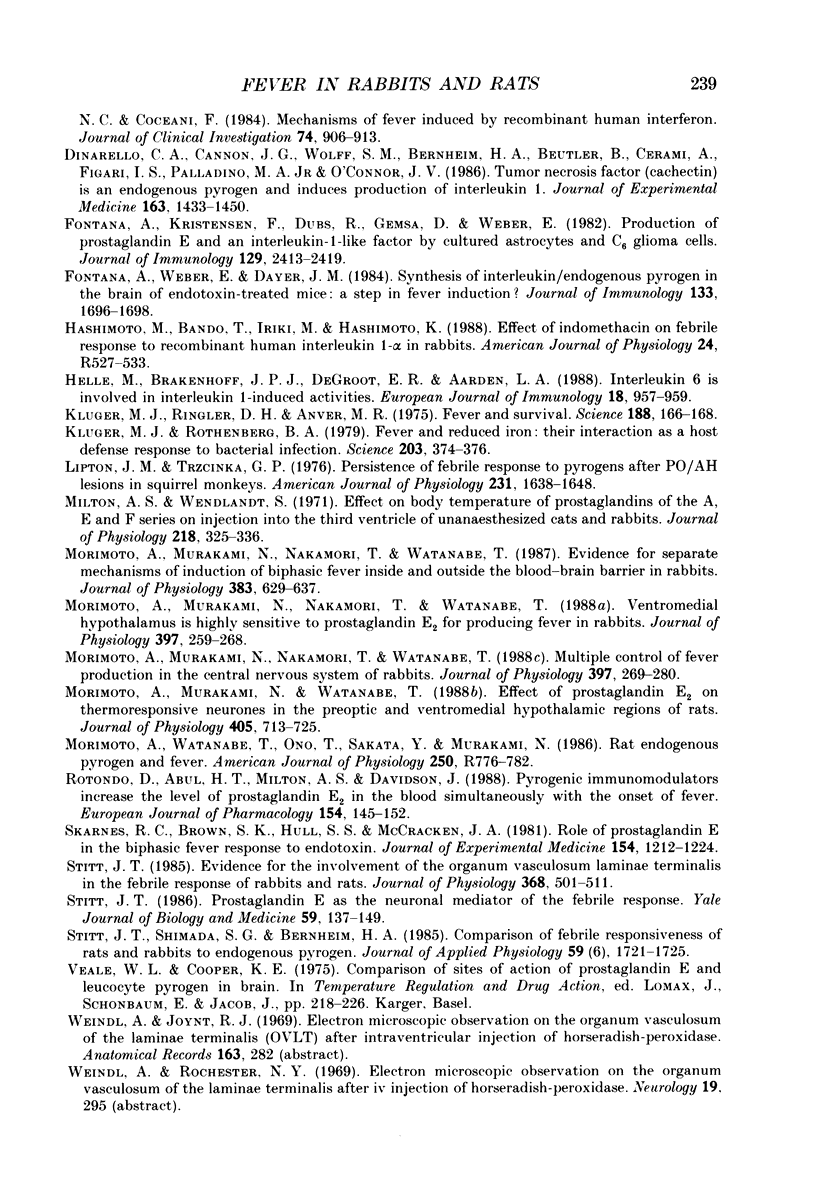
Images in this article
Selected References
These references are in PubMed. This may not be the complete list of references from this article.
- ATKINS E. Pathogenesis of fever. Physiol Rev. 1960 Jul;40:580–646. doi: 10.1152/physrev.1960.40.3.580. [DOI] [PubMed] [Google Scholar]
- Blatteis C. M., Banet M. Autonomic thermoregulation after separation of the preoptic area from the hypothalamus in rats. Pflugers Arch. 1986 May;406(5):480–484. doi: 10.1007/BF00583370. [DOI] [PubMed] [Google Scholar]
- Blatteis C. M., Bealer S. L., Hunter W. S., Llanos-Q J., Ahokas R. A., Mashburn T. A., Jr Suppression of fever after lesions of the anteroventral third ventricle in guinea pigs. Brain Res Bull. 1983 Nov;11(5):519–526. doi: 10.1016/0361-9230(83)90124-7. [DOI] [PubMed] [Google Scholar]
- Cooper K. E., Cranston W. I., Honour A. J. Observations on the site & mode of action of pyrogens in the rabbit brain. J Physiol. 1967 Jul;191(2):325–337. doi: 10.1113/jphysiol.1967.sp008253. [DOI] [PMC free article] [PubMed] [Google Scholar]
- Dascombe M. J., Milton A. S. Study on the possible entry of bacterial endotoxin and prostaglandin E2 into the central nervous system from the blood. Br J Pharmacol. 1979 Aug;66(4):565–572. doi: 10.1111/j.1476-5381.1979.tb13695.x. [DOI] [PMC free article] [PubMed] [Google Scholar]
- Dinarello C. A., Bernheim H. A. Ability of human leukocytic pyrogen to stimulate brain prostaglandin synthesis in vitro. J Neurochem. 1981 Sep;37(3):702–708. doi: 10.1111/j.1471-4159.1982.tb12544.x. [DOI] [PubMed] [Google Scholar]
- Dinarello C. A., Bernheim H. A., Duff G. W., Le H. V., Nagabhushan T. L., Hamilton N. C., Coceani F. Mechanisms of fever induced by recombinant human interferon. J Clin Invest. 1984 Sep;74(3):906–913. doi: 10.1172/JCI111508. [DOI] [PMC free article] [PubMed] [Google Scholar]
- Dinarello C. A., Cannon J. G., Wolff S. M., Bernheim H. A., Beutler B., Cerami A., Figari I. S., Palladino M. A., Jr, O'Connor J. V. Tumor necrosis factor (cachectin) is an endogenous pyrogen and induces production of interleukin 1. J Exp Med. 1986 Jun 1;163(6):1433–1450. doi: 10.1084/jem.163.6.1433. [DOI] [PMC free article] [PubMed] [Google Scholar]
- Dinarello C. A. Interleukin-1. Rev Infect Dis. 1984 Jan-Feb;6(1):51–95. doi: 10.1093/clinids/6.1.51. [DOI] [PubMed] [Google Scholar]
- Fontana A., Kristensen F., Dubs R., Gemsa D., Weber E. Production of prostaglandin E and an interleukin-1 like factor by cultured astrocytes and C6 glioma cells. J Immunol. 1982 Dec;129(6):2413–2419. [PubMed] [Google Scholar]
- Fontana A., Weber E., Dayer J. M. Synthesis of interleukin 1/endogenous pyrogen in the brain of endotoxin-treated mice: a step in fever induction? J Immunol. 1984 Oct;133(4):1696–1698. [PubMed] [Google Scholar]
- Hashimoto M., Bando T., Iriki M., Hashimoto K. Effect of indomethacin on febrile response to recombinant human interleukin 1-alpha in rabbits. Am J Physiol. 1988 Oct;255(4 Pt 2):R527–R533. doi: 10.1152/ajpregu.1988.255.4.R527. [DOI] [PubMed] [Google Scholar]
- Helle M., Brakenhoff J. P., De Groot E. R., Aarden L. A. Interleukin 6 is involved in interleukin 1-induced activities. Eur J Immunol. 1988 Jun;18(6):957–959. doi: 10.1002/eji.1830180619. [DOI] [PubMed] [Google Scholar]
- Kluger M. J., Ringler D. H., Anver M. R. Fever and survival. Science. 1975 Apr 11;188(4184):166–168. [PubMed] [Google Scholar]
- Kluger M. J., Rothenburg B. A. Fever and reduced iron: their interaction as a host defense response to bacterial infection. Science. 1979 Jan 26;203(4378):374–376. doi: 10.1126/science.760197. [DOI] [PubMed] [Google Scholar]
- Lipton J. M., Trzcinka G. P. Persistence of febrile response to pyrogens after PO/AH lesions in squirrel monkeys. Am J Physiol. 1976 Dec;231(6):1638–1648. doi: 10.1152/ajplegacy.1976.231.6.1638. [DOI] [PubMed] [Google Scholar]
- Milton A. S., Wendlandt S. Effects on body temperature of prostaglandins of the A, E and F series on injection into the third ventricle of unanaesthetized cats and rabbits. J Physiol. 1971 Oct;218(2):325–336. doi: 10.1113/jphysiol.1971.sp009620. [DOI] [PMC free article] [PubMed] [Google Scholar]
- Morimoto A., Murakami N., Nakamori T., Watanabe T. Evidence for separate mechanisms of induction of biphasic fever inside and outside the blood-brain barrier in rabbits. J Physiol. 1987 Feb;383:629–637. doi: 10.1113/jphysiol.1987.sp016433. [DOI] [PMC free article] [PubMed] [Google Scholar]
- Morimoto A., Murakami N., Nakamori T., Watanabe T. Multiple control of fever production in the central nervous system of rabbits. J Physiol. 1988 Mar;397:269–280. doi: 10.1113/jphysiol.1988.sp017000. [DOI] [PMC free article] [PubMed] [Google Scholar]
- Morimoto A., Murakami N., Nakamori T., Watanabe T. Ventromedial hypothalamus is highly sensitive to prostaglandin E2 for producing fever in rabbits. J Physiol. 1988 Mar;397:259–268. doi: 10.1113/jphysiol.1988.sp016999. [DOI] [PMC free article] [PubMed] [Google Scholar]
- Morimoto A., Murakami N., Watanabe T. Effect of prostaglandin E2 on thermoresponsive neurones in the preoptic and ventromedial hypothalamic regions of rats. J Physiol. 1988 Nov;405:713–725. doi: 10.1113/jphysiol.1988.sp017357. [DOI] [PMC free article] [PubMed] [Google Scholar]
- Morimoto A., Watanabe T., Ono T., Sakata Y., Murakami N. Rat endogenous pyrogen and fever. Am J Physiol. 1986 May;250(5 Pt 2):R776–R782. doi: 10.1152/ajpregu.1986.250.5.R776. [DOI] [PubMed] [Google Scholar]
- Rotondo D., Abul H. T., Milton A. S., Davidson J. Pyrogenic immunomodulators increase the level of prostaglandin E2 in the blood simultaneously with the onset of fever. Eur J Pharmacol. 1988 Sep 13;154(2):145–152. doi: 10.1016/0014-2999(88)90091-x. [DOI] [PubMed] [Google Scholar]
- Skarnes R. C., Brown S. K., Hull S. S., McCracken J. A. Role of prostaglandin E in the biphasic fever response to endotoxin. J Exp Med. 1981 Oct 1;154(4):1212–1224. doi: 10.1084/jem.154.4.1212. [DOI] [PMC free article] [PubMed] [Google Scholar]
- Stitt J. T. Evidence for the involvement of the organum vasculosum laminae terminalis in the febrile response of rabbits and rats. J Physiol. 1985 Nov;368:501–511. doi: 10.1113/jphysiol.1985.sp015872. [DOI] [PMC free article] [PubMed] [Google Scholar]
- Stitt J. T. Prostaglandin E as the neural mediator of the febrile response. Yale J Biol Med. 1986 Mar-Apr;59(2):137–149. [PMC free article] [PubMed] [Google Scholar]
- Stitt J. T., Shimada S. G., Bernheim H. A. Comparison of febrile responsiveness of rats and rabbits to endogenous pyrogen. J Appl Physiol (1985) 1985 Dec;59(6):1721–1725. doi: 10.1152/jappl.1985.59.6.1721. [DOI] [PubMed] [Google Scholar]



